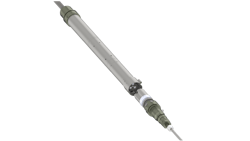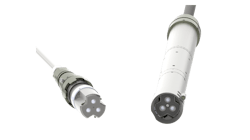OTC 2023: Teledyne’s optical feedthrough system provides real-time monitoring
Editor's note: Teledyne Marine has been awarded the Spotlight on New Technology Award from the Offshore Technology Conference (OTC).
Contributed by Teledyne Marine
Real-time monitoring of oil and gas production systems enhances safety, operational efficiency, environmental protection, regulatory compliance, asset integrity and emergency response capabilities. By leveraging advanced monitoring technologies and data analytics, operators can optimize production, minimize risks and ensure sustainable operations in the oil and gas industry. Teledyne’s 3-channel optical feedthrough (OFS) system provides real-time monitoring while reducing cost and extending the life of the system.
The challenge
Oil and gas production systems continue to push the limits of service life and seawater depth to maximize yields. This has led to increasingly complex monitoring requirements related to the system's performance and health, requiring real-time data with exceptional reliability.
HP/HT requirements, turbid seawater environment and increasing field service life in aggressive chemicals have created technical hurdles, including novel elastomer and thermoplastic qualification, extremes in HP/HT compensation systems, and the ability to mate and operate successfully in turbid environments. Some operators report that as many as 35% of subsea gauges no longer provide data after four years.
It can be challenging to find elastomer candidates that provide adequate sealing at low temperatures while maintaining good mechanical properties during harsh chemical exposures over the entire life of the field. Once a candidate material has been identified, it can take a year or more to complete the accelerated aging tests required to prove that the candidate can reliably survive harsh chemical exposures at high temperatures.
The solution
Teledyne has offered an optical subsea interconnect tool since 1995 with the 8-channel rolling seal wet-mate hybrid connector. Teledyne’s approach to the multi-channel OFS is based on this field-proven design, previous OFS FEED studies, extensive DGO EFS product line field history and Teledyne’s materials research investments.
The primary function of the OFS is to provide optical continuity between optical fibers present in the subsea distribution with optical fibers installed in the oil wells. The Teledyne OFS is an optical stab mate connector coupled when the XT is landed on the tubing hanger in the subsea environment. The system can provide a low-optical loss at each interface (2-dB maximum system insertion loss at 1,550 nm) with a low return loss termination—angled physical contact.
The following list of industry specifications has guided the development and qualification of the Teledyne OFS:
- SEAFOM TDS-01: Functional design and test requirements for an OFS used in subsea christmas tree installations;
- IEC 60068-2-14: Environmental testing – Part 2-14: Tests – Test N: Change of temperature;
- API 6A / ISO 10423: Specification for wellhead and christmas tree equipment;
- NACE MR-01-75 / ISO 15156: Materials for use in H2S-containing environments in oil and gas production;
- NORSOK Standard M-710: Qualification of non-metallic sealing materials and manufacturers; and
- NORSOK Standard M-001: Materials selection.
Teledyne’s 3-channel OFS provides the pressure integrity barrier to well fluids through the tubing hanger, christmas tree and wellhead system. It allows optical transmission through the tubing hanger and christmas tree for optical sensing downhole.
Operators value distributed acoustic sensing (DAS) because it provides real-time, continuous data along the length of the fiber, rather than traditional sensors that collect data at a single point. DAS, coupled with custom algorithms, can alert operators to early indicators of leaks, environmental issues and other pre-defined events, increasing the safety and life of the system while minimizing operating costs. DAS is especially attractive because a single fiber’s relatively low cost and small footprint can monitor several functions over a large section of the system.
Teledyne has successfully completed accelerated aging versus the expected chemical exposures in the Johan Sverdrup Field to confirm the 25-year reliability of the elastomer and thermoplastic materials used in the OFS.
The Teledyne OFS is qualified for an operating range of up to 10k psi and 0 C to 121 C with development work to increase the capacity to 15k psi and 0-138 C. These extreme temperatures and pressures, combined with high mating speeds (0.5 m/s), require developing a rugged HP/HT compensation system that reacts instantaneously, resists thermal and chemical degradation and provides long-term reliability. Additionally, the space available for the compensation system can be severely limited by existing features in the operator’s equipment.
The turbid environment introduces abrasive particles that can damage mating interfaces or contaminate optical interfaces at the mating connectors, causing a loss of optical continuity. Teledyne’s OFS utilizes an elastomeric face seal coupled with a flushing mechanism to trap damaging particulate and flush it away from the optical interfaces during the mating operation.
Case study
Teledyne’s 3-channel OFS was initially developed with Equinor for use in the Johan Sverdrup Field, the third largest oil field on the Norwegian Continental Shelf and has one of the lowest CO2 emissions of any oil field in the world.
When Equinor selected TechnipFMC to provide the subsea tree system for the Johan Sverdrup Phase 2, efforts began between TechnipFMC and Teledyne to integrate the Teledyne OFS into the TechnipFMC EVDT Completion System. Extensive qualification testing was performed to reach a Technology Readiness Level 4 (TRL) and to prove compliance with SEAFOM TSD-01, as well as other rigorous specifications related to elastomer aging, API 6A PSL3G and API 17D extended 200 cycle testing.
In March 2022, TRL 5 was achieved as Teledyne and TechnipFMC completed a system integration test to prove the live monitoring capability in the workshop. Multiple wet-mate connections between the christmas tree and tubing hanger were performed, and 690-bar cavity pressure tests were conducted to validate that the maximum separation test did not degrade optical performance.
The program is on track to deliver 18 systems within a year. Most of the OFS hardware for Johan Sverdrup Phase 2 has already been delivered and successfully integrated into TechnipFMC equipment. The first OFS systems have been installed subsea and are functioning correctly, as verified by optical time-domain reflectometer measurements.
Moving forward
In addition to the oil production applications of DAS, which require OFS, the industry is moving toward using previously decommissioned subsea well production infrastructure for carbon capture projects. In these instances, OFS/DAS is very attractive to enable monitoring of well integrity and seismic behavior in the formation.
Teledyne continues to invest in OFS technology, with a rich roadmap of product improvements planned. Some of these include higher temperatures and pressures, horizontal OFS designs, and tubing hanger running tool development, to name a few. Teledyne also is exploring an in-well wet-mate technology development.
References available upon request.
05.15.2023

